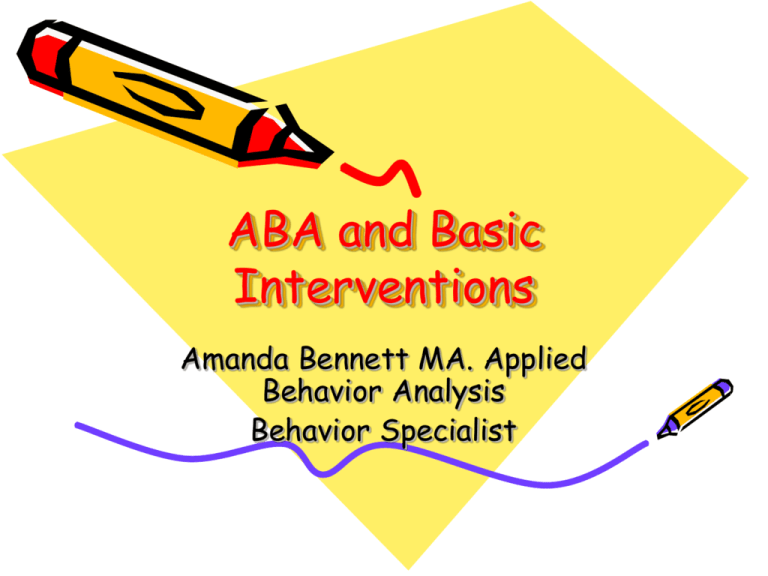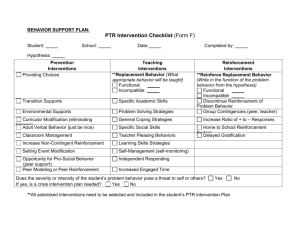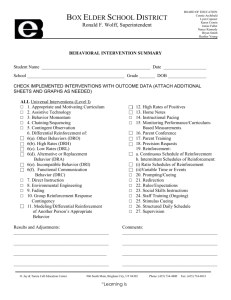File
advertisement

ABA and Basic Interventions Amanda Bennett MA. Applied Behavior Analysis Behavior Specialist What is ABA? • • • • • Discrete Trials? For children with autism? Bribing kids? Not natural? I don’t know. The answer….. • Applied Behavior Analysis.. • employs methods based on scientific principles of behavior to build socially useful repertoires and reduce problematic ones. Cooper et al 1989 This can include.. • Discrete Trials • Interventions for children with autism and other special needs. • Interventions for adults with special needs. • Incidental Teaching But Also…. • • • • • Traffic Safety Animal Training Staff development Getting your spouse to do the dishes. And much more… FBA FBA • Functional Behavior Assessment • In order to treat behavior effectively, we need to know why it is happening. • Should provide basis for Behavior Interventions. What do you mean by Function? • What is maintaining the behavior? • Think of principles of reinforcement and punishment. Have you ever…. • Gone to work so that you could get a paycheck? • Gone through a door that you always know is going to open? • Taken your shoes off so that your feet won’t hurt anymore? Reinforcement – Increases the likelihood that the behavior will occur again. • Positive Reinforcement: The delivery of a stimulus increases the likelihood of the behavior it follows. • Negative Reinforcement: The removal of a stimulus increases the likelihood of the behavior it follows. Have you ever… • Not picked up the phone, because you knew it was a telemarketer? • Stop going to a store, because customer service was poor? • Not touched a hot stove because it burned you before? Punishment – Decreases the likelihood that the behavior will occur again. • Positive Punishment (Type 1): The delivery of a stimulus decreases the likelihood of the behavior it follows. • Negative Punishment (Type 2): The removal of a stimulus decreases the likelihood of the behavior it follows. What are behavior functions? • What purpose is the behavior serving? – Social attention (positive reinforcement) • Praise • Reprimands – Access to something (positive reinforcement) • Activities, items What are behavior functions? - Escape something (negative reinforcement) -School work - Bad smell - Avoid others (negative reinforcement) -Trip to the principal’s office - Automatic reinforcement - Self-stimulatory behavior (handflapping, etc.) Basic Behavior Interventions Things to note… • Behavior Interventions should be based on a Functional Assessment (or working in that direction) • An intervention for one student will not work for every student. Each should be individualized, although some strategies may be similar. Preventative Strategies And Functional Interventions (Not an exhaustive list!) Possible Antecedent Strategies • • • • • • • • Location of desk in room Peer proximity Teacher proximity Noise level Ways of communicating message Visual cues Daily schedules Modifications to schedule Functional Intervention: Attention-Seeking Behavior • Provide attention to any appropriate behavior • What if the behavior engages in an appropriate behavior at inappropriate frequencies? (e.g., raising hand every minute) – – – – “Catch them being good!” This should be done every couple of minutes through a thumbs up, verbal praise, pat on the back, etc. The behavior may be appropriate but occur at an intolerable frequency For example, a student may raise his/her hand frequently in class. We might reinforce the student for not raising his/her hand every minute. (see next slide) Functional Intervention: Attention-Seeking Behavior • Ignore! – If attention is maintaining the behavior, ignoring the behavior is necessary – There are different levels of ignoring: • • • Walk away from the child. No physical interaction, no eye contact, no verbal interaction . Provide physical interaction without eye contact or verbal interaction. This may be necessary to maintain a safe situation. This could include a “time out” situation Functional Interventions: Escape-Motivated Behavior – Task choice: teacher vs. student – Task preference: preferred followed by nonpreferred – Task novelty: novel vs. repetitive – Predictable vs non-predictable schedule – Teacher presentation of material: difficult/easy, oral/written, pacing – Embedded instruction: interspersing easy and difficult tasks Functional Interventions: Escape-Motivated Behavior • • Determine skill deficit or performance deficit Demand Fading • Use escape as a reinforcer • Teach appropriate replacement behavior • • • • • Reduce the number of demands Instead of requiring the student to complete 20 math problems, require the completion of 5 problems Frequent breaks Use of a break card: Once the student has completed x number of problems, allow them to take a break This may be teaching them to ask for a break Functional Interventions: Escape- Motivated Behavior • Stop letting them get out of the non-preferred activity!! – Once we stop delivering the reinforcement maintaining the behavior, the student is likely to stop engaging in the behavior • Example: – – Do not allow the student to escape or avoid the demand or activity permanently (temporarily is sometimes ok) Following the inappropriate behavior, require the child complete at least part of the task or activity » Guided compliance (hand over hand) » Broken record procedure Functional Interventions: Escape- Motivated Behavior • Teach a more appropriate behavior – Reward the student when he/she engages in a different behavior (like asking for a break appropriately) • • You might start out rewarding them every time they appropriately ask for a break. Because this isn’t a practical solution, you will stop continuously honoring the request, and maybe only honor it every other time and so on. Functional Intervention: Access to Preferred Item/Activity – Access to the preferred item no longer follows the inappropriate behavior • Example: Every time Cindy screams in class, we let her play on the computer so that she is quiet. – What do we do? • Teach appropriate request for the item and reinforce with immediate access to the item Functional Intervention: Automatic Reinforcement • • Ex: self-stimulatory behaviors, stereotypy Teach a different behavior that provides a sociallyappropriate way to get the same reinforcement as the self-stimulatory behavior – – – Gum Chewing Squeeze Ball Hands in Pockets Functional Intervention: Automatic Reinforcement • Block the reinforcement. – Do not allow access to reinforcement. – Block behavior vs. reinforcer. DATA COLLECTION Data Collection • Necessary to see objective look at behavior. Hitting Vs. 30 25 20 Rate On 9-1-07, he was hitting me a lot, and he is still hitting me a lot on 9-4-07. He is not improving. 15 10 5 0 8/31/0 9/1/07 9/2/07 9/3/07 9/4/07 9/5/07 7 Date Also… • Necessary to make appropriate changes. • Necessary to demonstrate effectiveness of treatment. • Helps to keep consultants and teachers informed. • Helps to keep us on-task. Some types of data collection… • • • • • • • • Frequency Duration Latency Permanent Product Time-Sampling Interval ABC Data Scatterplot Questions?







